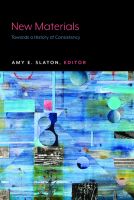New Materials
Towards a History of Consistency
Abstract
This edited volume gathers eight cases of industrial materials development, broadly conceived, from North America, Europe and Asia over the last 200 years. Whether given utility as building parts, fabrics, pharmaceuticals, or foodstuffs, whether seen by their proponents as human-made or “found in nature,” materials result from the designation of some matter as both knowable and worth knowing about. In following these determinations we learn that the production of physical novelty under industrial, imperial and other cultural conditions has historically accomplished a huge range of social effects, from accruals of status and wealth to demarcations of bodies and geographies. Among other cases, <i>New Materials</i> traces the beneficent self-identity of Quaker asylum planners who devised soundless metal cell locks in the early 19th century, and the inculcation of national pride attending Taiwanese carbon-fiber bicycle parts in the 21st; the racialized labor organizations promoted by California orange breeders in the 1910s, and bureaucratized distributions of blame for deadly high-rise fires a century later. Across eras and global regions <i>New Materials</i> reflects circumstances not made clear when technological innovation is explained solely as a by-product of modernizing impulses or critiqued simply as a craving for profit. Whether establishing the efficacy of nano-scale pharmaceuticals or the tastiness of farmed catfish, proponents of new materials enact complex political ideologies. In highlighting their actors’ conceptions of efficiency, certainty, safety, pleasure, pain, faith and identity, the authors reveal that to produce a “new material” is invariably to preserve other things, to sustain existing values and social structures.
Keywords
Industrial materials developmentDOI
10.3998/mpub.11675425ISBN
9781643150130Publisher
Lever PressPublisher website
https://www.leverpress.org/Publication date and place
2020Classification
Mechanical engineering and materials


 Download
Download Web Shop
Web Shop